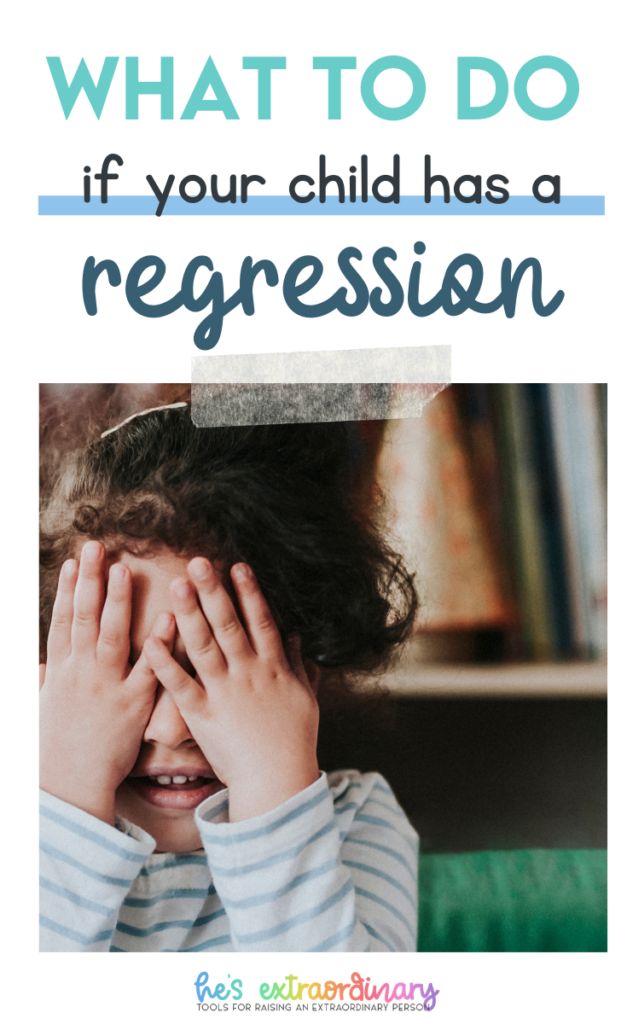What To Do If Your Child Has A Developmental Regression
What’s inside this article: A look at developmental regression – what they are, when and why they happen, and how to respond if your child is going through a regression.
A developmental regression is when a child loses developmental skills they’d previously acquired. Typically, social or language skills are lost, but regressions can also affect other skills like sleeping and toileting.
Regressions sometimes happen to children with autism but can also occur in neurotypical children after a stressful life event or a significant change.
If your child has a regression, you’ll probably find yourself saying, “all of a sudden, my child can’t do that thing they always did before”
Note, this is different than what some call “regressive autism“; when a child appears to develop typically but then starts to lose speech and social skills, typically between the ages of 15 and 30 months, and is subsequently diagnosed with autism.
How to Tell if Your Child is Having a Regression
The most obvious sign of a regression is the loss of skills your child had previously mastered.
Signs may include:
- Suddenly having accidents after being toilet trained for several months
- No longer sleeping through the night or new challenges falling asleep
- Increased clinginess and meltdowns
- Loss of language skills or social skills
- Increased stimming – flapping hands, rocking, spinning
When you see these signs, especially if you can pinpoint a stressful event or a significant change, you should know this: these different reactions all mean the same thing.
Your child is asking for your reassurance and support.
Punishment and pressure are likely to backfire, and a gentler approach will have more success.
Dealing with Developmental Regression:
1. Identify the Trigger
For autistic children, the trigger isn’t always immediately identifiable. Small changes in routine can cause significant stress because children with autism need consistency and routine to thrive.
The trigger could be something you see as “small” like dad starting a new job, so mom is doing the daycare drop-off instead.
Or more significant, like a move, new school, an illness, divorce, etc.
And, let’s face it, after the pandemic hit, most of us experienced changes to our daily routine. So it could be that, or it could be things changing again as they get back to how they used to be. The last two years have brought with them a lot of uncertainty.
So, if it’s possible, identify the trigger as best you can. It will help you emphasize, validate, and set new routines and expectations.
2. Be kind
Empathize with the changes and losses your child is going through. Validate their experience. They’ll probably need help understanding and expressing their feelings.
Depending on their age and the cause of the regression, you can help your child through communication strategies such as emotion coaching, visual aids like social stories, children’s books on experiencing and coping with the trigger, and imaginative play.
3. Establish Routine
Routine, structure, and consistency are essential. If your child’s regression is due to a sudden change, whether welcoming a new sibling at home or attending a new school, creating new routines and structures will help.
The sooner you can establish a new normal, with new predictable expectations and routines, the better.
Visual supports help when teaching and implementing new routines and provide a reference point for your child when they’re looking for reassurance.
4. Get Some Physical Activity
Exercise reduces stress – that may be why your child is stimming more frequently or acting more hyperactive than usual.
When your child is dysregulated, their brain produces high levels of the stress hormone cortisol. It also produces adrenaline. An increase in cortisol increases anxiety and dysregulation.
When this occurs, functional and social communication skills decrease – because the brain can’t access the prefrontal cortex, which controls executive functioning.
This leads to meltdowns, causing a massive spike in adrenaline because the fight or flight response is triggered.
Exercise is proven to reduce cortisol and adrenaline levels.
Occupational therapists usually recommend short periods of intense physical activity several times a day over one extended workout session. Plus, shorter intervals are more fun for kids, and you won’t be as likely to lose their attention.
For best results, aim for four to six exercise sessions lasting 8-10 minutes each.
What’s even better, during exercise, the brain releases endorphins and dopamine. Increased dopamine levels improve the functions of synapses in the brain. As a result, communication ability improves, as does the ability to retrieve information.
Here are 15 fun workouts to try with your kids.
5. Enjoy nature
Being outside improves mood and lowers stress, so finding more ways to spend time in nature can help your child feel better.
Eat meals on your patio, do yard work together (bonus points for heavy work), garden, go for walks or spend more time at the playground.
6. Adjust Expectations as Needed
For the time being, adjust your expectations for your child.
If they suddenly stop being able to fall asleep alone, you may need to lay with them or stay near their bed as they fall asleep again, the same way you did before.
Suppose they’re experiencing an increase in meltdowns, either the frequency or intensity. In that case, it’s important to respond to these meltdowns extremely consistently and make it clear during these times that they are safe and you are there to co-regulate.
You cannot discipline or punish a child into re-learning skills lost during a developmental regression. Patience, guidance, and time will help your child redevelop these skills.
7. Ask your pediatrician
Trust your gut.
If in doubt about anything, always talk with your child’s doctor about any concerns you have. They can provide more suggestions or direct you to additional supports.
They can also run tests to rule out medical issues if necessary.

Some regressions last for a few weeks, others longer, but it varies from child to child.
Usually, if you can pinpoint what might be going on and support your child through it, they will work through it and regain those lost skills. But, if your concerns are prolonged, reach out to your child’s primary health care provider for help.

